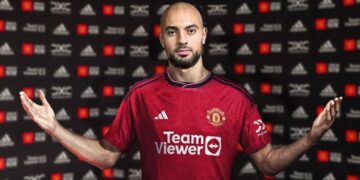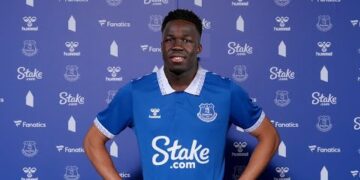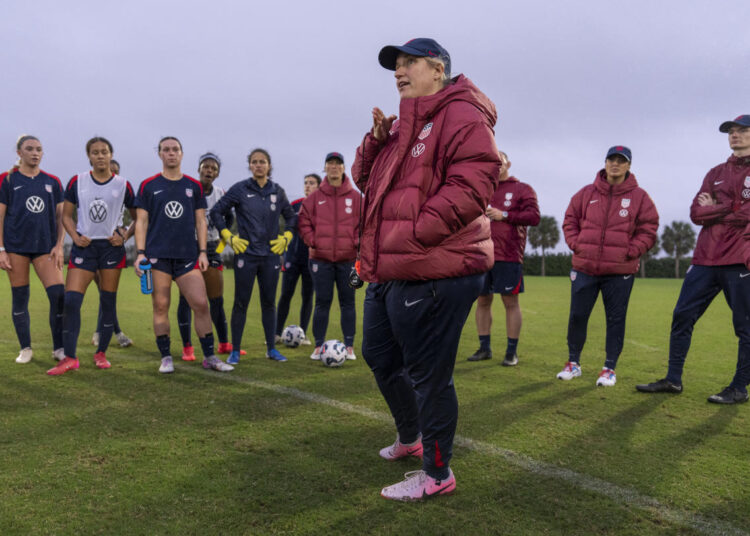Emma Hayes began with a powerpoint, but soon ditched it and spoke from the heart. She was outlining her paradigm-shifting vision for U.S. soccer. She’d been refining it for months, but really, she said, “I feel like I’ve worked on this my whole life.” She’d lived it as a London girl, in an age when boys’ teams were her only soccer outlet; and as an aspiring coach, in courses designed for and taught by men. “Within our game,” she said, everything “has been centered through a male bias and a male lens.”
And that, now, in her role as U.S. women’s national team head coach, is what she wants to change.
She also wants to win, of course, “but for the WNT,” she told a small group of reporters via Zoom this week, “it goes further than that.”
Ever since she returned from Paris, where the USWNT won Olympic gold in her 11th week on the job, Hayes has been constructing a plan to revolutionize women’s soccer. She wants to use her power, as the highest-paid coach of the sport’s most popular team, to fundamentally rejigger how everyone — from coaches to performance scientists to data analysts to U.S. Soccer Federation marketing execs — approaches the women’s game. Countless customs, rules, tactics, systems and so on have been copied or adapted from men’s soccer. Hayes has been asking provocative questions that boil down to one: If they weren’t copied, and were instead designed principally for women, how would they be different?
And she has been “challenging everybody across the federation, internally,” to reflect on “how they’ve been viewing the women’s game through that male lens.”
Hayes wants to replace it with a “female lens” that, she believes, could reshape the sport — and keep the USWNT atop it.
That is the vision and “mission” she’s presented, powerpoint and all, to youth national team staff and U.S. Soccer leadership: “Architect a ‘Female blueprint’ to win and set the bar for the global game.”
Reshaping the men’s soccer mold
The “male lens” is a legacy of centuries-old sexism, and when Hayes urges you to look for it — humbly, intentionally — you realize it’s ubiquitous. Nearly every aspect of soccer, from the size of the field to the lexicon to the strategies that teams employ, was developed by men, for men in the 20th century, when most women were banned or strongly discouraged from even playing the sport.
So, as women’s soccer grew in the 21st century, it was funneled into the mold of men’s soccer. The formations and training programs and league structures that worked on the men’s side were the natural reference point. The commercial schemes and passing techniques and footwear were replicated, or at least became the women’s starting point. And the experts came, too, often without considering that the starting points might be faulty.
“So often, so many people come into the women’s game, and they have little to no knowledge of females whatsoever,” Hayes said. “None. They have knowledge of their area of expertise, which is crucial. … But there are real differences between men and women. And … they just get dismissed.”
The result, Hayes explained, is the U-14 coach who knows how to run a defensive drill, but has no clue what to do when one of his players starts her period.
It’s the pro coach who idolizes Pep Guardiola, and espouses the same ideals, but has never even pondered that the pace or spacing of women’s soccer might be different. “In the men’s game, a left back can hit a ball in behind an opposing left back. But you [typically] can’t do that in the women’s game,” Hayes said, by way of example. “So, it alters the way I might think, in terms of how I might set a team up defensively.”
It’s also the rehab regimens that haven’t accounted for female physiology. It’s the facilities that might be gorgeous, but don’t fulfill a woman’s needs. It’s the administrator who, for a road trip, picks a hotel simply because the men’s team loved it. It’s the analytics and Expected Goal (xG) models that have transformed modern soccer — but were based on data from the men’s game.
It’s even the social media intern who posts a seemingly innocuous photo to Instagram, but doesn’t understand how society has conditioned women to think about body image.
“If you’re taking that photograph in exactly the same way you do a male player, and you share that at the wrong angle — let me tell you, as a coach, I could be spending weeks and months on that,” Hayes said. “I might need to get clinical support. Over a photograph.”
These are the types of conversations Hayes has been having with the ever-expanding staff at U.S. Soccer.
“I want people to be uncomfortable,” she said.
And some have been. “I have people even within my staff that are so unaware of their own biases,” Hayes noted. “And they’re not living in Zambia, nor Spain; they’re living in the U.S. And they’re working in the best program in the world. And they’re like, … ‘I’m ashamed of myself for some of the things I’ve been doing, just because I hadn’t even reflected on that as a woman, and [the potential] impact.’”
Hayes’ push to rebuild the system
Hayes also knows, though, that her staff is but a small sliver of a sprawling soccer ecosystem. To truly revolutionize the sport, “we know we’ve gotta get down to the younger age groups as quick as possible,” she said.
To do that, she hopes that U.S. Soccer will create a distinct women’s coaching education department, rather than looping the women’s game into courses that, traditionally, have been rooted in men’s soccer. In the redesigned system she envisions, there’d be a Pro License, a B License, a C License and so on specifically tailored — “physiologically, anatomically, technically, tactically, psychologically, socially, emotionally” — to women’s soccer.
“We can’t talk about creating the best environments for our girls, women, all over the country, until we prioritize the systems that are there to support us,” Hayes said.
She also wants to work with professional leagues — namely the NWSL and USL — on what she calls a “pro game advisory board.”
She wants to work with Nike, and with universities, to develop “research projects” and “sports science degrees that are specific to females.”
She’d also love to spread her gospel to the ECNL, the Girls Academy and other prestigious youth leagues, but “that,” she admitted, “will be a humongous challenge.” U.S. Soccer has long struggled to control those independent, profit-driven amateur clubs — where soccer-playing teens do most of their learning.
Still, though, Hayes is optimistic. She’s energized. “This is the single most exciting project I’ve ever been involved with,” she said.
In between USWNT camps, she is working long hours with the federation on things like coaching education and “stakeholder engagement,” both of which she called “absolutely essential.”
She is also managing a player pool. She’ll lead the USWNT to the 2027 World Cup. She wants to win it, and to host the 2031 World Cup, and to win that one, too.
But she has these grander ambitions, the impact of which “I doubt will be felt in its entirety until I’ve gone,” she said.
“I’ve worked my entire career,” Hayes said, “to get to a place where I’ve got the ability to influence, and the power to influence something much broader and much bigger than me.” And she intends to use it.
Read the full article here



























Discussion about this post